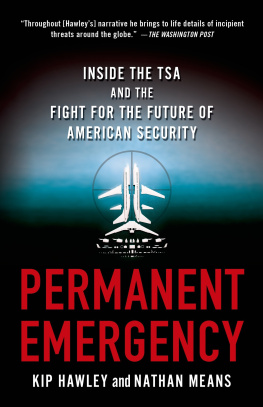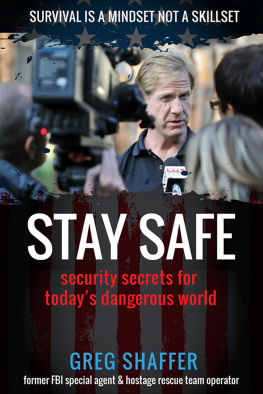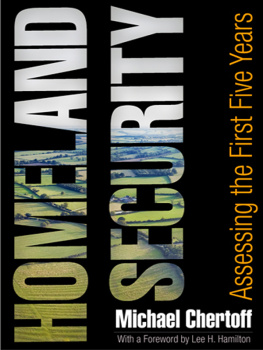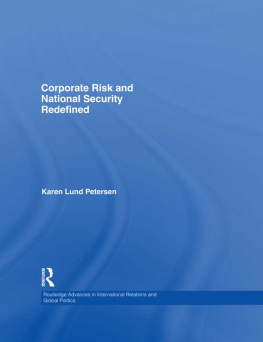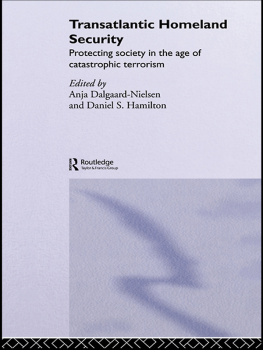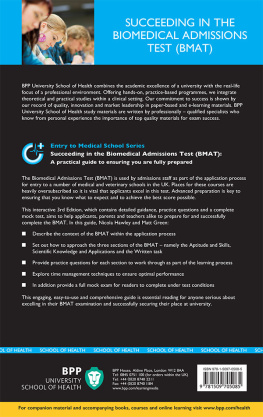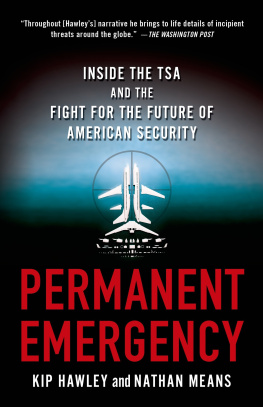PERMANENT
EMERGENCY
INSIDE THE TSA AND THE FIGHT FOR
THE FUTURE OF AMERICAN SECURITY
KIP HAWLEY AND NATHAN MEANS

The author and publisher have provided this e-book to you for your personal use only. You may not make this e-book publicly available in any way. Copyright infringement is against the law. If you believe the copy of this e-book you are reading infringes on the authors copyright, please notify the publisher at: us.macmillanusa.com/piracy.
For Jan
Kip
For Xan
Nathan
PERMANENT EMERGENCY
Copyright Kip Hawley and Nathan Means, 2012
All rights reserved.
For information, address St. Martins Press, 175 Fifth Avenue, New York, N.Y. 10010.
First published in 2012 by PALGRAVE MACMILLAN in the U.S.a division of St. Martins Press LLC, 175 Fifth Avenue, New York, NY 10010.
ISBN: 978-0-230-12095-2
Our eBooks may be purchased in bulk for promotional, educational, or business use. Please contact the Macmillan Corporate and Premium Sales Department at 1-800-221-7945, ext. 5442, or by e-mail at .
Library of Congress Cataloging-in-Publication Data
Hawley, Edmund S. (Edmund Summers), 1953
Permanent emergency : inside the TSA and the fight for the future of American security / Kip Hawley and Nathan Means.
p. cm.
Includes index.
ISBN 978-0-230-12095-2 (hardback)
1. United States. Transportation Security Administration. 2. Transportation Security measuresUnited States. 3. Aeronautics, CommercialSecurity measuresUnited States. 4. AirportsSecurity measuresUnited States. 5. TransportationEffect of terrorism onUnited States. 6. September 11 Terrorist Attacks, 2001. I. Means, Nathan. II. Title.
HE194.5.U6H39 2012
363.32593880973dc23
2011036787
A catalogue record of the book is available from the British Library.
Design by Letra Libre, Inc.
First edition: April 2012
Printed in the United States of America.
CONTENTS
AUTHORS NOTES
PERMANENT EMERGENCYIS AN INSIDERS LOOK AT THE TSA from its inception after the attacks of 9/11/2001 till the present, told by a few of the people who were there. It is not a memoir or a history of the TSA. Permanent Emergency is intended as a quick read for people who want to better understand the issues that play out in airports every day and counterterrorism in general. I hope it provides enough background and perspective to motivate readers to actively debate our security future.
In order to keep the story line moving, many of the most important players in TSAs history have had their stories and role trimmed in the editorial process. This is especially true of key players like Congress, airlines, airports, surface transportation, the media, and other communities, because we would have had to double the books length to do them justice. I certainly dont forget them and know that, while they never sought recognition for their important roles, I nonetheless regret not being able to share their contributions in these pages. I am deeply grateful to the characters in Permanent Emergency for allowing me to use their true stories, even if they were not always glorious, in an effort to allow the public to see inside the TSA.
Given that time has intervened and that many of the scenes in Permanent Emergency took place without notes being recorded, I have tried to capture as best I could the actions and quotes attributed to the characters. In all cases except those attributed to possible al-Qaeda operatives, my sources are first person participants. All of the major American characters and our European allies are real people with their actual names and true biographical information. While the stories told are accurate, we changed the names and identifying characteristics of some of the ancillary figures out of respect for their privacy.
Regarding sensitive information, I tried to achieve a balance between portraying reality in its technical and operational details so as to give the reader a true look and feel without providing something useful to those who would harm us. To that end, on occasion I have simplified certain processes or omitted details, or presented as a single scene a composite of events that occurred over time. I am indebted to a number of experts at TSA who read the manuscript with an eye toward achieving this balance. Also, the Office of the Director of National Intelligence provided valuable guidance to protect currently sensitive intelligence information.
Throughout my experience at TSA, I heard, you cant make this stuff up and truth is stranger than fiction on a weekly basis. The startling, unrelenting, clear-eyed focus of terror operatives planning viable attacks on civilian transportation playing out daily against a backdrop of the disconcerting public saga that is the TSA is hard to get down on paper. To convey that very real drama, we needed to give the reader a sense of what it was like on the other side, with al-Qaeda.
In my descriptions of particular operatives I have drawn on what is known generally about their trade-craft and used an amalgam of information known about several operatives where necessary. Where information about an operatives activity during a specific period was unknown, I filled in the gaps with my best guess based on consultations with professionals who track that kind of detail. I have used material from the extensive record that exists in think tanks, journalists accounts, personal interviews, evidence used in criminal trials, law enforcement reporting from outside the United States, and the Internet. I did not use information gained exclusively from what I learned in government service, but rather used that experience to sort the credibility of accounts I uncovered elsewhere.
Permanent Emergency gives a realistic depiction of the action even when, for security reasons or lack of specific knowledge, our narrative does not portray literal fact. In other words, where I have lightly fictionalized an event, detail, or process, what is included in the book pales in comparison to what really happened. Truth is truly more startling than fiction and, if anything, Permanent Emergency dampens the urgency, currency, and criticality of our need to stay ahead of the terrorist threat.
PREFACE
ON THE MORNING OF DECEMBER 25, 2009, ABOUT A YEAR AFTER I left the top spot at the Transportation Security Administration, the passengers for Northwest Flight 253 lined up at Amsterdams sleek Schiphol International Airport to be herded, pushed, poked, prodded, and grilled by airport security.
Belts came off, along with jackets, keys, cell phones, PDAs, iPods, and anything else that might trip the walk-through alarm and bring on the annoying wand, the dreaded pat down, or worst of all, the long walk to an interrogation room. Passengers slipped laptops out of their cases. They prayed that the perfumes and medicines and contact solutions they had bagged in plastic would pass inspection. On the far side of the x-ray machines, security personnel dismantled untold hours of careful Christmas wrapping to get a better look at the presents inside. Meanwhile, the plastic bins just in front of the security barriers filled to overflowing with discarded water and soda bottles, innocent boxes of baby formula and Ensure, and the odd bottle of wine purchased just steps earlier in the duty-free shops by passengers who believed the sealed Schiphol security bags were okay to bring on a US-bound flight.

